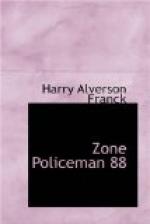Off in the vortex of the city lolls Panama’s public market, where Chinamen are the chief sellers and flies the chief consumers. Myriads of fruits in every stage of development and disintegration, haggled bits of meat, the hundred sights and sounds and smells one hurries past suggest that Panama may even have outdone Central America before Uncle Sam came with his garbage-cans and his switch. Further on, down at the old harbor, lingers a hint of the picturesqueness of Panama in pre-canal days. Clumsy boats, empty, or deep-laden with fruit from, or freight to, the several islands that sprinkle the bay, splash and bump against the little cement wharf. Aged wooden “windjammers” doze at their moorings, everywhere are jabbering natives with that shifty half-cast eye and frequent evidence of deep-rooted disease. Almost every known race mingles in Panama city, even to Chinese coolies in their umbrella hats and rolled up cotton trousers, delving in rich market gardens on the edges of the town or dog-trotting through the streets under two baskets dancing on the ends of a bamboo pole, till one fancies oneself at times in Singapore or Shanghai. The black Zone laborer, too, often prefers to live in Panama for the greater freedom it affords—there he doesn’t have to clean his sink so often, marry his “wife,” or banish his chickens from the bedroom. Policemen with their clubs swarm everywhere, for no particular reason than that the little republic is forbidden to play at army, and with the presidential election approaching political henchmen must be kept good-humored. Not a few of these officers are West Indians who speak not a word of Spanish—nor any other tongue, strictly speaking.
Rubber-tired carriages roll constantly by along Uncle Sam’s macadam, amid the jingling of their musical bells. Every one takes a carriage in Panama. Any man can afford ten cents even if he has no expense account; besides he runs no risk of being overcharged, which is a greater advantage than the cost. All this may be different when Panama’s electric line, all the way from Balboa docks to Las Sabanas, is opened—but that’s another year. Meanwhile the lolling in carriages comes to be quite second nature.
But like any tropical Spanish town Panama seethes only by night, especially Saturday and Sunday nights when the paternal Zone government allows its children to spend the evening in town. Then frequent trains, unknown during the week, begin with the setting of the sun to disgorge Americans of all grades and sizes through the clicking turnstiles into the arms of gesticulating hackmen, some to squirm away afoot between the carriages, all to be swallowed up within ten minutes in the great sea of “colored” people. So that, large as may be each train-load, white American faces are so rare on Panama streets that one involuntarily glances at each that passes in the throng.




